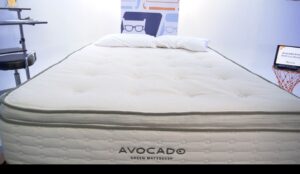Dunlop vs. Talalay Latex
Disclosure: By clicking on the product links in this article, Mattress Nerd may receive a commission fee at no cost to you, the reader. Read full disclosure statement.
One of the most important decisions you’ll make when shopping for a mattress is which mattress material to invest in. For example, you may choose a mattress composed of memory foam, steel coils, or a combination of the two. Another popular bedding material is latex, which has become prized both because it’s comfortable and also because it can be eco-friendly.
Latex mattresses tend to come in two basic types: Talalay latex and Dunlop latex. These two terms refer to unique latex manufacturing processes, which can in turn impact the overall feel and performance of the bedding. The question is, which type of latex mattress is best-suited for your sleep preferences? Once you’ve figured that out, head over to our articles on the best latex mattresses and best organic mattresses for more info.
What is Latex Foam?
To begin with, let’s consider some basics. Latex is a natural material, derived from the sap found in rubber trees. It’s used in a wide range of industrial applications, including not only mattresses but also tennis shoes, sporting goods, and rubber bands.
Natural latex can be turned into a foam material, somewhat resembling the look and feel of memory foam. However, there are some key distinctions. Latex foam tends to be a lot more elastic than memory foam, which means it has more of a “bounce” to it. (And bouncier beds tend to be popular among those who change positions during the night.)
Additionally, latex foam is more porous than memory foam, meaning there is more space for air to circulate between foam particles. This means natural latex mattresses tend to sleep a little bit cooler than memory foam.
One of the main selling points for latex is that it gives you a chance to sleep on something completely natural, but be careful: Not every latex mattress is made from all-natural or organic materials. Some mattresses are made with synthetic latex, which tends to be cheaper, and others blend the two. If you’re looking into latex mattresses for the purpose of getting something eco-friendly, it’s wise to double-check that the product you’re investigating is indeed certified as natural.
What Are Talalay and Dunlop Latex?
Talalay and Dunlop represent the two primary types of latex mattress. The primary distinction here is how they are manufactured. In other words, both Talalay and Dunlop latex begin with the same basic materials; what’s different is the process used to turn those materials into mattress foam.
Dunlop Latex Manufacturing Process
Let’s start with the Dunlop manufacturing process, which is the simpler of the two. Because of this, Dunlop latex mattresses tend to be more affordable than Talalay ones. The Dunlop process was actually the first method developed for manufacturing latex foam; it was devised in 1929, and all these years later, the process hasn’t changed very much.
Here’s a basic outline of the Dunlop process:
- The process begins with a latex extract in liquid form. It’s mechanically whipped until it coalesces into a frothy foam.
- This foam is then moved into a mold.
- The latex foam is placed into a vulcanization oven, where it is baked at high heat.
- Once fully baked, the latex is taken out of the oven and carefully washed.
- The material is then baked a second time in order to remove any remaining moisture.
This process results in latex foam that’s fairly dense and firm. The composition of Dunlop latex also tends to be bottom-heavy; that is, it’s firmer at the bottom than it is at the top. This composition makes Dunlop latex well-suited for the inner support layer of a mattress, though it’s not always the best choice for the top layer.
Talalay Latex Manufacturing Process
Developed in the 1940s, the Talalay process is a little bit more complicated. Because the process is more involved, the price point for a Talalay mattress is usually a little higher. Here’s a rough sketch of the Talalay manufacturing process:
- As with the Dunlop process, Talalay manufacturing begins with a liquid latex extract, which is whipped into a foam.
- The foam is then placed into a mold, though crucially, that mold is only partially filled.
- The mold is then vacuum-sealed. The effect of this is that the foam inside starts to expand.
- The foam is frozen, and carbon dioxide is pushed through the latex.
- The frozen material is then placed into an oven and baked.
- Once baked, the latex is removed from the oven, taken out of its mold, washed, and set to dry.
This process yields latex foam that’s softer than what you’d get from the Dunlop method. This fluffier, less-dense foam is great for the top of a mattress, though not as ideal for the support layer.
Because the Dunlop and Talalay methods are in some senses complementary (one is well-suited for the comfort layer of a mattress, the other for the support layer), you’ll find many latex mattress products that use both materials to achieve the desired product.
Pros and Cons of Talalay Latex
Talalay latex mattresses offer their own pros and cons. We’ll start with the positives:
- Talalay latex is usually fluffier, which means it’s probably the one you’d want on the top layer of your mattress.
- While both types of latex are temperature-neutral, Talalay tends to be slightly better in this regard. As such, it’s a little bit more effective at mitigating body heat.
- While Talalay latex is not considered to be as durable as Dunlop, it’s still more durable than most other mattress materials.
As for some negatives:
- Due to the more cumbersome manufacturing process, Talalay latex is generally a bit more expensive than Dunlop. (And no matter which type of latex you get, you’re likely to pay a higher price point than if you just got a straight memory foam mattress.)
- The Talalay manufacturing process is also a little more energy-intensive than Dunlop, which means it’s the lesser option as far as sustainability goes.
Pros and Cons of Dunlop Latex
Dunlop latex also comes with some unique advantages and disadvantages. First, some pros to choosing a Dunlop latex foam mattress:
- Thanks to its simpler manufacturing process, Dunlop is a little less expensive than Talalay.
- Also, with a less energy-intensive process, Dunlop is the more eco-friendly of the two options.
- Because it is firmer and denser, Dunlop is usually the best bet for the support core layer of a mattress.
- Dunlop is generally considered to be the more durable of the two options.
As for drawbacks, consider:
- As with Talalay latex, Dunlop will almost always cost more than memory foam.
- With regard to temperature neutrality, Dunlop latex doesn’t fare quite as well as Talalay.
Which One is Better?
Any time you’re in the market for a new mattress, there are a number of factors you’ll need to balance, from price point to cooling properties, from firmness level to edge support. A lot of those factors are going to inform your decision about the type of mattress material you choose, whether that’s natural latex or something else.
The decision about Dunlop vs. Talalay latex probably isn’t going to be top-of-mind, yet once you decide to get a latex bed, it makes sense to at least think about the different attributes of these two latex types. They differ in a few notable ways, though either way, you can end up with a mattress that’s comfortable, durable, and well-made.


